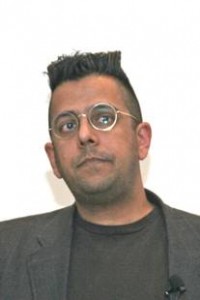April 19, 2010
The Big Bang
Dr Simon Singh
Report by: Mike Dryland
The Flamsteed was delighted to welcome Simon Singh in a more relaxed frame of mind after the resolution of the libel suit brought against him by the British Chiropractic Association. Simon has been preoccupied with his defence against this action for two years. We look forward to seeing more from his pen when he can tie-up loose ends.
Simon came to talk to us about the Big Bang. His book of the same name was published over 5 years ago now and remains one of the best surveys of the history of man’s theorising as to how the Universe developed to what we see today — one of the most fundamental of the ‘great questions’ of science and philosophy.
Simon began by pointing out that our present theory has matured only during the last 30 years — a mere blinking of the eye even in terms of the timescale of modern science. Just 70 years ago Sir James Jeans was writing about an eternal, static Universe. Now we think of an evolving Universe that had a start point. We are the first to have such a theory backed-up with evidence.
Almost the first to expound what became the Big Bang theory was the Belgian priest Georges Lemaitre. Lemaitre was an early authority on Einstein’s theory of General Relativity and realised that an unchanging eternal Universe was unstable — it had to be contracting or expanding. He talked about an expanding Universe which had appeared from a ’primordial atom’. Lemaitre’s thinking was slow to catch-on maybe because as a priest, his ideas were interpreted as a biblical-type creation.
What Lemaitre’s ideas needed was corroborative data. Such data appeared in the late-1920s with the revolutionary work of Edwin Hubble and Milt Humason. Working with the 100-inch reflector at Mt Wilson in California, they had measured the distance to several ‘nebulae’ and also measured their radial speed relative to us. Hubble first resolved the ‘Great Debate’ by showing that many of the nebulae were ‘island universes’ — independent galaxies outside our own Milky Way galaxy. He then showed that most were receding from us at phenomenal speeds, and that their speed of recession was proportional to their distance (Hubble’s Law) — an effect we would expect to see in an expanding Universe.
Calculations of the age of the Universe based on Hubble’s early data were troubling — it seemed like the Earth (at least 3.5 bill. years old) was older than the Universe (about 1.5 bill. years old). Simon related how time would show that Hubble had been mislead because he was unaware that the stars used as distance indicators (the Cepheid variables first calibrated by Henrietta Leavitt Swan) actually existed in two different populations with different characteristics. Based on modern data we now believe the Universe is 13 to 14 bill. years old and the Earth about 4.5 bill. During his narrative Simon weaves a great tale of how Hubble’s progress was based ‘brick by brick’ on a foundation laid down by the pioneers of spectroscopy (Huggins et al), Doppler and red-shift, and Pickering and Leavitt’s work.
In a sense the Big Bang’s problems just started with Hubble’s ideas. There was plenty of room for dissent from opponents like Fritz Zwicky with his ‘tired light’ theory, and famously of course, Hoyle, Gold, and Bondi, with Steady State theory. It was Fred Hoyle who coined the term ‘Big Bang’ intended to disparage, but it caught on.
The Big Bang got a real boost from the work of Gamow, Alfa, and Hermann who not only used the theory to calculate verifiable ratios of Hydrogen to Helium in the Universe (about 10 to 1), but also predicted that there should be a residual background of microwave radiation left over — the dying echo of the Big Bang. The CMB Cosmic Microwave Background was finally detected in the 1960s by Penzias and Wilson.
Simon’s book is a great read — one of the thrilling scientific ‘whodunnits’, and his presentation is a joy to witness. He is a great presenter, clear and entertaining, and he delights in surprising with unexpected twists and turns and off-beat views. A great evening out!
Read more at —
‘Successes & problems of Big Bang Cosmology’ – Michael Joyce
Posted under: Flamsteed, Flamsteed Lecture, Meeting Report







You must be logged in to post a comment.